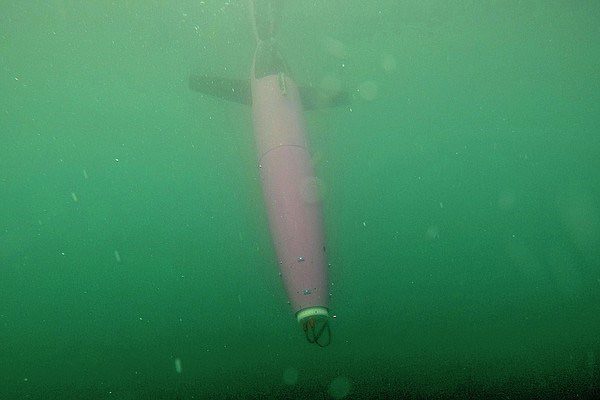An unmanned underwater vehicle equipped with a large sensor to measure carbon dioxide (CO2) levels in the ocean has successfully completed its mission on its first night at Resurrection Bay in Alaska, USA.
Deployed in Alaska’s Bay this spring to explore new insights into the ocean’s chemical environment amid climate change, this autonomous device is specially designed to dive to depths of 1,000 meters and “journey” to remote areas of the sea.
This device is expected to provide a significant advancement in monitoring greenhouse gas emissions in the ocean, as until now, measuring CO2 levels—a method for quantifying ocean acidification—has primarily been conducted through ships, buoys, and anchored devices on the ocean floor.

CO2 monitoring device in the ocean.
Mr. Andrew McDonnell, a marine scientist at the School of Fisheries and Ocean Sciences at the University of Alaska Fairbanks, stated: “Ocean acidification is a process where humans emit CO2 into the atmosphere through fossil fuel combustion and land use changes.”
The oceans have done humanity a favor by actively absorbing a significant amount of CO2. Without this, the CO2 levels in the atmosphere would be much higher, causing the Earth to warm more rapidly. However, Claudine Hauri—a marine scientist at the International Arctic Research Center at the University of Alaska Fairbanks—added: “But the issue is that the chemical environment in the ocean is currently changing due to this absorption.”
Research shows that ocean acidification can harm and kill certain marine organisms. Meanwhile, the increasing acidity in the oceans affects the shell formation process of some marine species, making them more vulnerable to predators or leading to their extinction.
For the past few weeks, Mr. Andrew McDonnell and his wife, Ms. Hauri McDonnell, have been collaborating with engineers from the Republic of Cyprus Consulting and Service Supply Company, which provides submersibles, and 4H-Jena, a German company that supplies sensors for unmanned underwater vehicles.
Every day, they have been sending the submersible further into Resurrection Bay from their starting point in the coastal community of Seward to conduct tests. Once programmed, the device autonomously follows navigation instructions, knowing when to sample and when to surface and send a positioning signal back to the ship for retrieval. At the end of its journey, this 59 kg device is pulled back onto the ship, the sensors are removed, and the data is uploaded to a server for analysis.
The sensor, measuring 0.30 meters in length and 15.24 cm in diameter, resembles a laboratory in a tube, equipped with pumps, valves, and membranes to separate gas from seawater. The sensor analyzes CO2 and logs and stores data within a temperature-controlled system. Many components of this sensor operate on battery power.
According to Mr. Richard Feely, a senior scientist at the National Oceanic and Atmospheric Administration’s Pacific Marine Environmental Laboratory, the impacts of acidification have been documented in the Northwest Pacific on species such as oysters, Dungeness crabs, and many others. Previously, Canadian scientists had attached a smaller prototype CO2 sensor to an unmanned device in the waters off Labrador but concluded that this device did not meet the ocean acidification monitoring goals.
Mr. Andrew McDonnell and his team aim to establish a fleet of submersibles operating across all oceans globally in the future, providing more accurate assessments and better predictions for the future.


















































